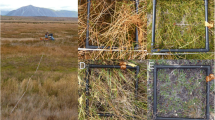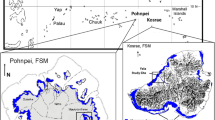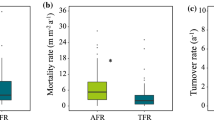Abstract
Effects of flooding on root dynamics appear nonlinear and therefore difficult to predict, leading to disparate and often contradictory reports of flooding impacts on production in bottomland hardwood forests. We explored root dynamics in two adjacent wetland habitats by comparing results obtained from several methods of estimating root processes. Also, we tested the influence of flooding on root dynamics of cherrybark, overcup, water and swamp chestnut oaks. Fine root biomass in the laurel oak habitat was greater (α< 0.05) than in the swamp tupelo habitat (5.7 vs. 2.4 Mg ha−1), as was fine root necromass (2.4 vs. 1.3 Mg ha−1), productivity (2.3 vs. 0.3 Mg ha−1 yr−1 when the sum of significant increments method was used, 5.6 vs. 2.5 Mg ha −1 yr−1 when the maximum minus minimum method was used, and 1.2 vs. 1.0 Mg ha−1 yr −1, when the root screen method was used), and turnover (40% and 12% per year). Mortality estimates were lower in the laurel oak habitat (1.3 and 1.2 Mg ha−1 yr−1) than in the swamp tupelo community (2.8 and 2.1 Mg ha−1 yr−1) when significant increment and maximum minus minimum methods were used, respectively. This apparent contradiction between estimates of production and mortality may be due to more rapid decomposition rates in the more aerated soil of the laurel oak than in the swamp tupelo forest type. Roots in the swamp tupelo habitat appeared to be longer-lived than in the laurel oak habitat. We concluded that there was greater investment in roots in the laurel oak habitat, where a shallow rooting zone and episodes of flooding and drought required drastic changes in root structure and physiology. In contrast, the swamp tupelo habitat had a deeper rooting zone and more consistently moist to flooded hydroperiod, allowing flood adapted roots to persist. The four oak species varied in their phenology of root production and response to flooding, from no difference among treatments for overcup oak to dramatic reductions in root growth during and after flooding for cherrybark oak. Flooding enhanced or at least did not negatively influence root growth in overcup oak, but seriously impacted root growth and survival of cherrybark oak and swamp chestnut oak. Different responses were attributed to the timing of root production: root growth began early for cherrybark oak so spring flooding severely affected this species. Growth in overcup oak began later and ended earlier than the other species tested, allowing the species a means of avoiding flood stress.
Similar content being viewed by others
References
Angelov M N, Sung S S, Doong R L, Harms W R, Kormanik P P and Black C C Jr. 1996 Long-and short-term flooding effects on survival and sink-source relationships of swamp-adapted tree species. Tree Physiol. 16: 477–484.
Baker T T, III, Conner W H, Lockaby B G, Stanturf J A, and Burke M K 2001 Fine root productivity and dynamics on a forested floodplain in South Carolina. Soil Sci. Soc. Am. J. 65, 545–556.
Broadfoot W M 1967 Shallow-water impoundment increases soil moisture and growth of hardwoods. Soil Sci. Soc. of Am. Proc. 31(4), 562–564.
Burke M K, Raynal D J and Mitchell M J 1992 Soil nitrogen availability influences seasonal carbon allocation patterns in sugar maple (Acer saccharum). Can. J. For. Res. 22, 447–456.
Burke M K and Raynal D J 1994 Fine root growth phenology, production, and turnover in a northern hardwood forest ecosystem. Plant Soil 162, 135–146.
Burke M K, King S L, Eisenbies M H and Gartner D 2000a Vegetation and soils. In The Coosawhatchie Bottomland Ecosystem Study, a report on the development of a reference wetland. Eds. M K Burke and M H Eisenbies. pp. 23–28. USDA Forest Service General Technical Report SRS-38, Southern Research Station, Asheville, NC.
Burke M K, Liechty H O and Eisenbies M H 2000b Aboveground and belowground net primary production. In The Coosawhatchie Bottomland Ecosystem Study, a report on the development of a reference wetland. Eds. M K Burke and M H Eisenbies. pp. 39–42. USDA Forest Service General Technical Report SRS-38, Southern Research Station, Asheville, NC.
Caldwell M M 1987 Competition between root systems in natural communities. In Root Development and Function. Eds. P J Gregory, J V Lake and D a Rose. pp. 167–185. Cambridge University Press, New York.
Crawford R M M 1993 Plant survival without oxygen. Biologist 40, 110–114.
Day F P, Jr and Megonigal J P 1993 The relationship between variable hydroperiod, production allocation, and belowground organic turnover in forested wetlands. Wetlands 13, 115–121.
Edwards M B 1990 Swamp chestnut oak. In Silvics of North America, Volume 2, Hardwoods. Eds. E M Burns and B H Honkala. pp. 693–696. Agriculture Handbook 654, Forest Service United States Department of Agriculture, Washington, DC.
Edwards N T and Harris W F 1977 Carbon cycling in a mixed deciduous forest floor. Ecology 58, 431–437.
Eisenbies M H and Hughes W B 2000 Hydrology. The Coosawhatchie Bottomland Ecosystem Study, a report on the development of a reference wetland. Eds. M K Burke and M H Eisenbies. pp. 10–13. USDA Forest Service General Technical Report SRS-38, Southern Research Station, Asheville, NC.
Eissenstat D M, Wells C E, Yanai R D and Whitbeck J L 2000 Building roots in a changing environment: implications for root longevity. New Phytol. 147, 33–42.
Eissenstat D M 1997 Trade-offs in root form and function. Ecology in Agriculture. Ed. L E Jackson. pp. 173–199. Academic Press, San Diego, CA.
Fredrickson L H 1978 Lowland hardwood wetlands: Current status and habitat values for wildlife. Wetland Functions and Values: the State of our Understanding. Eds. P E Greeson, J R Clark and J E Clark. pp. 296–306. American Water Resources Association, Minneapolis, MN, USA.
Gill R A and Jackson R B 2000 Global patterns of root turnover for terrestrial ecosystems. New Phytol. 147, 13–31.
Hall T F and Smith G E 1955 Effects of flooding on woody plants. J. For. 53(4), 281–285.
Harms W R, Schreuder H T, Hook D D, Brown C L and Shropshire F W 1980. The effects of flooding on the swamp forest in Lake Ocklawaha, Florida. Ecology 61, 1412–1421.
Hook D D and Brown C L 1973 Root adaptations and relative flood tolerance of five hardwood Species. For. Sci. 19(3), 225–229.
Hook D D, Brown C L and Kormanik P P 1971 Inductive flood tolerance in swamp tupelo (Nyssa sylvatica var. biflora (Walt.) Sarg.). J. Exp. Bot. 22, 79–89.
Hosner J F and Boyce S G 1962 Tolerance to water saturated soil of various bottomland hardwoods. For. Sci. 8(2), 180–186.
Hupp C R 2000 Hydrology, geomorphology, and vegetation of Coastal Plain rivers in the southeastern USA. Hydrological Processes 14, 2991–3010.
Hupp C R and Schening M R 2000 Sedimentation. The Coosawhatchie Bottomland Ecosystem Study, a report on the development of a reference wetland. Eds. M K Burke and M H Eisenbies. pp. 14–16. USDA Forest Service General Technical Report SRS-38, Southern Research Station, Asheville, NC.
Jones R H, Lockaby B G and Somers G L 1996 Effects of microtopography and disturbance on fine-root dynamics in wetland forests of low-order stream floodplains. Am. Midl. Nat. 136, 57–71.
Krinard R M 1990 Cherrybark oak. In Silvics of North America, Volume 2, Hardwoods. Eds. R M Burns and B H Honkala. pp. 640–649. Agriculture Handbook 654, Forest Service United States Department of Agriculture, Washington, DC.
Kurz W A and Kimmins J P 1987 Analysis of some sources of error in methods used to determine fine root production in forest ecosystems: a simulation approach. Can. J. For. Res. 17, 909–912.
Lauenroth W K, Hunt H W, Swift D M Singh J S 1986 Reply to Vogt et al., Ecology 67, 580–582.
Levan MA and Riha SJ 1986 The precipitation of black oxide coatings on flooded conifer roots of low internal porosity. Plant Soil 95, 33–42.
McClaugherty C A, Aber J D and Melillo J M 1982 The role of fine roots in the organic matter and nitrogen budgets of two forested ecosystems. Ecology 63, 1481–1490.
McReynolds R D and Hebb E A 1990 Laurel oak. In Silvics of North America, Volume 2, Hardwoods. Eds. R M Burns and B H Hankala. pp. 677–680. Agriculture Handbook 654, Forest Service, United States Department of Agriculture, Washington, DC.
Megonigal J P and Day F P 1992 Effects of flooding on root and shoot production of bald cypress in large experimental enclosures. Ecology 73, 1182–1193.
Melhiush F M and Lang A R G 1968 Quantitative studies of roots in soil. 1. Length and diameters of cotton roots in a clay-loam soil by analysis of surface-ground blocks of resin-impregnated soil. Soil Sci. 100, 16–22.
Melhuish F M and Lang A R G 1971 Quantitative studies of roots in soil. 2. Analysis of non-random populations. Soil Sci. 112, 161–166.
Miller E N 1971 Soil Survey of Charleston County, South Carolina. United States Department of Agriculture, US Government Printing Office, Washington, D.C., 20402. 78pp. +maps.
Murray L A, Eppinette B and Thorp J H 2000 Geomorphology and soil survey. In The Coosawhatchie Bottomland Ecosystem Study, a report on the development of a reference wetland. Eds. M K Burke and M H Eisenbies. pp. 7–90. USDA Forest Service General Technical Report SRS-38, Southern Research Station, Asheville, NC.
Powell S W and Day F P Jr 1991 Root production in four communities in the Great Dismal Swamp. Am. J. Bot. 78, 288–297.
Publicover D A and Vogt K A 1993 A comparison of methods for estimating forest fine root production with respect to sources of error. Can. J. For. Res. 23, 1179–1186.
Rendig V V and Taylor H M 1989 Principles of soil-plant interrelationships. McGraw-Hill Publishing Company, New York.
SAS Institute 1985 SAS User's guide, version 5 edition, SAS Institute, Cary, NC.
Singh J S, Lauenroth W K, Hunt H W and Swift D M 1984 Bias and random errors in estimators of net root production: a simulation approach. Ecology 65, 1760–1764.
Solomon J D 1990 Overcup oak. In Silvics of North America, Volume 2, Hardwoods. Eds. R M Burns and B H Honkala. pp. 681–685. Agriculture Handbook 654, Forest Service United States Department of Agriculture, Washington, DC.
Steele R G D and Torrie J H 1960 Principles and procedures of statistics. McGraw-Hill Book Company, New York, NY.
Stuck W M 1980 Soil survey of Beaufort and Jasper Counties, South Carolina. United States Department of Agriculture, US Government Printing Office, Washington, DC, 20402. 179 pp. +maps.
Symbula M and Day F P Jr 1988 Evaluation of the methods for estimating belowground production in a freshwater swamp forest. Amer. Mid. Nat. 120, 405–415.
Vogt K A, Grier C C, Bower S T, Sprugel D G and Vogt D J 1986a Overestimation of net root production: a real or imaginary problem? Ecology 67, 577–579.
Vogt K A, Vogt D J and Bloomfield J 1998 Analysis of some direct and indirect methods for estimating root biomass and production of forests at an ecosystem level. Plant and Soil 200, 71–89.
Vogt K A, Vogt D J, Moore E E Sprugle D G 1989 Methods considerations in measuring biomass, production, respiration, and nutrient resorption for tree roots in natural ecosystems. In Application of Continuous and Steady-state Methods to Root Biology. Eds. J G Torrey and L J Winshop. pp. 217–232. Kluwer Academic Publishers, Dordrecht, Netherlands.
Vozzo J A 1990 Water oak. In Silvics of North America, Volume 2, Hardwoods. Eds. R M Burns and B H Honkala. pp. 701–703. Agriculture Handbook 654, Forest Service United States Department of Agriculture, Washington, DC.
Wharton C H, Kitchens W M, Pendleton E C and Sipe T W 1982 The ecology of bottomland hardwood swamps of the southeast: a community profile. Publ. No. FWS/OBS-81/37, U.S. Fish ad Wildlife Service, Washington, DC.
Wigley T B and Filer T H Jr 1989 Characteristics of green tree reservoirs: A survey of managers. Wildl. Soc. Bull. 17, 136–142.
Young G L, Karr B L, Leopold B D and Hodges J D 1995 Effect of greentree reservoir management on Mississippi bottomland hardwoods. Wildlife Soc. Bull. 23(3), 525–531.
Author information
Authors and Affiliations
Corresponding author
Rights and permissions
About this article
Cite this article
Burke, M.K., Chambers, J.L. Root dynamics in bottomland hardwood forests of the Southeastern United States Coastal Plain. Plant and Soil 250, 141–153 (2003). https://doi.org/10.1023/A:1022848303010
Issue Date:
DOI: https://doi.org/10.1023/A:1022848303010




